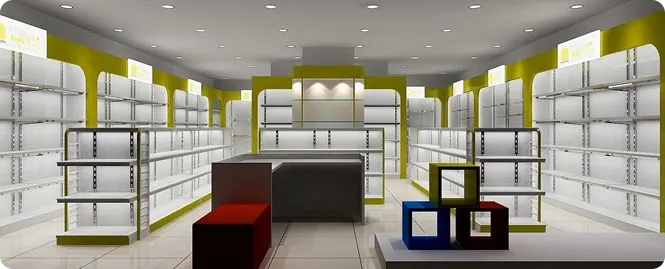How to Open a Convenience Store in Oklahoma
Table of Contents
Key Takeaways
-
Before opening a convenience store in Oklahoma, analyze customer demographics, competition, and high-traffic areas to choose the best location for success.
-
Obtain the necessary licenses and permits, including an occupancy permit, business registration, and health department approvals, to ensure compliance with state regulations.
-
A solid business plan helps secure funding through loans or investors and outlines expenses like rent, utilities, and inventory.
-
Selecting the right point of sale system, designing an efficient store layout, and hiring well-trained customer service staff enhance operations and customer experience.
-
A well-planned marketing and promotion strategy, combined with attractive deals and a smooth opening day preparation, helps build brand awareness and attract customers.
The convenience store industry is expanding in Oklahoma due to increasing consumer demand for quick, accessible shopping options. With fast-paced lifestyles, people rely on convenience stores for snacks, beverages, and groceries. Entrepreneurs can capitalize on the growing market by opening a well-located and efficiently managed store. However, competition is strong, making proper planning essential. A successful convenience store requires strategic decisions regarding location, inventory selection, and operational efficiency to attract customers and ensure long-term profitability.
Understanding the steps and legal requirements is critical when opening a convenience store in Oklahoma to ensure compliance and long-term success. Business owners must obtain the necessary licenses and permits, including an occupancy permit, to operate legally. Creating a strong business plan also helps secure funding and outline essential costs. Implementing an efficient point-of-sale system and prioritizing customer service will improve operations, assisting the store in attracting and retaining customers from day one.
Step 1: Researching the Market and Location
Choosing the right location is key when opening a convenience store in Oklahoma. A successful store should be easily accessible, visible, and situated in an area with high foot traffic. Proximity to residential neighborhoods, highways, or busy intersections can attract more customers, increasing their loyalty and ensuring steady business sales.
Studying local competition helps identify gaps in the market and unique selling points. Understanding consumer needs, like preferred products and shopping habits, allows owners to stock relevant inventory. Researching demographics, income levels, and peak shopping hours ensures the store effectively caters to its target audience and stands out from competitors.
A high-traffic area increases the store’s visibility and sales potential. Consider locations near gas stations, office buildings, schools, and public transit stops. Parking availability, ease of entry and exit, and nearby businesses also impact customer convenience. Evaluating foot and vehicle traffic patterns helps determine the best spot for maximum profitability.
.webp)
Step 2: Business Plan Development
Selecting the right location is key to running a successful convenience store in Oklahoma. Look for areas with high visibility, accessibility, and steady foot traffic. Locations near residential neighborhoods, gas stations, or major roads attract more customers. A well-placed store ensures consistent sales and a competitive edge in the market.
Understanding the level of competition helps identify what products and services are already available. Researching consumer needs—such as shopping preferences, peak hours, and product demand—allows store owners to tailor inventory accordingly. Analyzing pricing strategies and promotional efforts of competitors also helps create a unique market position and attract loyal customers.
A high-traffic area increases customer flow and revenue potential. Consider locations near offices, schools, public transit stops, or shopping centers. Ensure convenient parking, easy accessibility, and minimal competition. Observing daily traffic patterns and customer behavior will help determine whether the area can sustain long-term business growth and overall profitability.

Step 3: Legal Requirements and Permits
Before opening a convenience store in Oklahoma, it is important to secure the required licenses and permits. These may include obtaining a business license, occupancy permit, health permits for food sales, and an alcohol or tobacco license, if applicable. Ensuring compliance with state and local regulations prevents legal issues and business disruptions.
Zoning laws determine where businesses can and cannot operate. Check local regulations to ensure your chosen location is zoned for retail use. Additional requirements may include parking space availability, signage restrictions, and building codes. Understanding these guidelines can help avoid fines and ensure smooth business operations from the start.
To operate legally, register your business with the Oklahoma Secretary of State and obtain an Employer Identification Number (EIN) when you’re hiring employees. Additionally, a sales tax permit from the Oklahoma Tax Commission is required to collect and remit sales tax on goods sold, ensuring compliance with state tax laws.

Step 4: Securing Financing
Securing funding is a vital step when opening a convenience store in Oklahoma. Entrepreneurs can explore various financing options, including business loans, investor partnerships, and personal savings. Small Business Administration (SBA) loans offer favorable terms, while private investors can provide additional capital in exchange for equity. Personal savings reduce debt but require careful budgeting. Evaluating each option based on repayment terms, interest rates, and financial stability ensures the right funding source for long-term business success.
Having well-prepared financial documents is essential for securing a loan or attracting reliable investors. Create a detailed business plan that includes your store’s startup costs, revenue projections, and expense breakdowns. Prepare balance sheets, profit and loss statements, and cash flow projections to demonstrate financial viability. A professional presentation that showcases market research, competitive advantages, and growth potential increases credibility. Ensuring accuracy and clarity in financial reports improves the chances of securing funding efficiently.

Step 5: Choosing the Right Store Format
One of the first decisions when opening a convenience store is operating independently or joining an existing franchise. An independent store offers full control over branding, inventory, and pricing, allowing flexibility and unique product selections. A franchise, however, provides brand recognition, an existing customer base, and operational support. While franchises require a higher initial investment and ongoing fees, they simplify marketing and streamline processes, making them a popular choice for some entrepreneurs.
Running an independent store allows for creativity, complete profit retention, and customized product offerings, but it also demands significant effort in marketing and customer acquisition. A franchise benefits from corporate support, supplier connections, and brand trust but comes with restrictions and franchise fees. To make an informed decision, consider budget, experience, and long-term goals. Entrepreneurs who prefer independence may opt for their own store, while those seeking structure may find franchising more appealing.

Step 6: Store Design and Layout
A well-designed store layout enhances your business’s efficiency and improves the overall customer experience. The entrance should be welcoming, leading the customers smoothly through aisles with clear signage and an intuitive flow. High-demand products should be placed in easily accessible areas, while impulse-buy items can be positioned near the checkout. Wide aisles, organized shelves, and proper lighting create a comfortable shopping environment. Prioritizing functionality and convenience ensures a smooth shopping experience and encourages repeat visits.
Strategic product placement influences customers' purchasing decisions and, in turn, maximizes business sales. Essential and high-margin products should be kept at eye level, while everyday necessities can be placed more profound in the store to encourage browsing. End-cap displays and checkout counters are ideal for impulse purchases. By adequately utilizing shelf space, keeping pathways clear, and grouping related products, owners can further enhance both convenience and accessibility, ultimately increasing the store’s revenue and overall customer satisfaction.

Step 7: Purchasing Equipment and Inventory
Setting up a convenience store requires specific essential types of equipment for smooth operations. This includes cash registers or point-of-sale systems for transactions, shelving units for product display, and refrigeration units for perishable goods. Security cameras, lighting, and storage solutions are crucial to maintaining efficiency, organization, and customer convenience.
Finding reliable suppliers guarantees a well-stocked store. Partner with wholesalers, local distributors, and direct manufacturers to source snacks, beverages, and household essentials at competitive prices. Building strong relationships with suppliers can lead to better pricing, bulk discounts, and a consistent inventory flow, helping maintain customer satisfaction and business profitability.
Effective inventory management helps prevent shortages and overstocking. Use tools like inventory tracking software to monitor sales trends and adjust orders accordingly. Establish a reordering schedule for high-demand items to ensure shelves remain stocked. Regular audits and supplier coordination help streamline restocking, reduce waste, and maintain a balanced, cost-effective inventory.

Step 8: Hiring and Training Staff
Finding the right employees is crucial for running smooth operations and providing excellent customer service. Look for candidates with good retail experience, strong communication skills, and reliability. Clearly define job roles, including cashiers, stock clerks, and store managers. Use online job boards, local advertisements, and referrals to attract applicants. Conduct thorough interviews and background checks to ensure trustworthiness. Hiring friendly, detail-oriented staff helps create a positive shopping experience and fosters customer loyalty.
Effective employee training helps ensure smooth store operations and enhances overall customer satisfaction. This training should cover cash handling, POS system usage, store policies, and loss prevention. Employees must also be familiarized with best practices for customer services, including greeting customers, handling complaints, and maintaining a clean store environment. Arranging regular refresher courses and hands-on training improves efficiency, reduces errors, and creates a more professional, knowledgeable team that enhances the overall shopping experience.

Step 9: Marketing and Promotion
A strong marketing strategy is essential to driving foot traffic and building a loyal customer base. Focus on brand visibility, competitive pricing, and special promotions. Eye-catching signage, an inviting storefront, and targeted promotions can help attract new customers. Understanding the local market and customer preferences ensures effective marketing efforts.
Local advertising through flyers, newspaper ads, and radio spots helps increase awareness. Offering discounts, bundle deals, and seasonal promotions encourages repeat visits. Social media platforms like Facebook, Instagram, and Google My Business can drive engagement through regular updates, promotions, and customer interaction, helping to expand your store’s reach and visibility.
Engaging with the local community fosters trust and enriches long-term customer relationships. Participate in neighborhood events, sponsor local initiatives, or collaborate with nearby businesses to get more engagement. Implementing loyalty programs—such as point-based rewards or exclusive member discounts—encourages repeat business and enhances customer retention, ultimately boosting sales and brand loyalty.

Step 10: Opening Day Preparations
A successful grand opening sets the tone for your convenience store. Ensure the shelves are fully stocked, the staff is well-trained, and all equipment is properly functioning. Finalize store displays, signage, and promotional materials. Create excitement by spreading the word through local advertising, social media, and community outreach.
Hosting a soft opening allows you to test store operations before the official launch. Invite friends and family and select customers to shop and provide feedback. This helps identify potential issues with customer service, inventory management, and store layout, allowing you to make adjustments and ensure a smoother grand opening.
Special promotions and discounts are powerful tools for attracting customers. Implementing limited-time discounts, a loyalty program, and free samples will create a strong buzz around your product. Partnering with local businesses or influencers increases visibility. A well-planned promotional strategy encourages customer engagement and helps establish your store in the community.

Conclusion
Opening a convenience store involves several key steps, including market research, business planning, obtaining permits, securing financing, and choosing a store format. Proper store layout, inventory management, employee hiring, and marketing strategies are crucial for success. A well-executed launch ensures long-term profitability and a strong presence in the local market.
Insurance protects your business from risks like theft, property damage, liability claims, and employee-related incidents. Policies like general liability, business interruption, and workers’ compensation insurance help cover unexpected losses. Proper insurance ensures financial stability, safeguards assets, and provides peace of mind, allowing business owners to focus on growth and operations.

